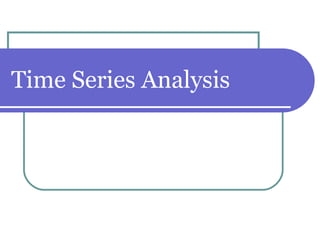
Time series slideshare
- 2. Time Series Analysis A Time Series is a collection of observations made sequentially in time. According to Ya-lun Chou, “A Time Series may be defined as a collection of readings belonging to different time periods, of some economic variables or composite of variables” Examples: Financial time series, scientific time series, Demographic time series, Meteorological time series
- 3. Time series data Vs. Cross Sectional data Time series data Cross Sectional data Time-series data is a set of observations collected at usually equally spaced time intervals. Cross-sectional data are observations that coming from different individuals or groups at a single point in time Time series data usually follows one subject's changes over the course of time. Cross-sectional data refers to data collected by observing many subjects (such as individuals, firms or countries/regions) at the same point of time. It focuses on results gained over an extended period of time, often within a small area It focuses on the information received from surveys and opinions at a particular time, in various locations, depending on the information sought. Example: The daily closing price of a certain stock recorded over the last six weeks is an example of time-series data Example: The closing prices of a group of 20 different stocks on December 15, 1986 this would be an example of cross- sectional data
- 4. Cont… A study on random sample of 4000 graphics from 15 of the world’s news papers published between 1974 and 1989 found that more than 75% of all graphics were time series. Sales figures jan 98 - dec 01 0 5 10 15 20 25 30 35 40 45 jun-97 jan-98 jul-98 feb-99 aug-99 mar-00 okt-00 apr-01 nov-01 maj-02
- 5. Cont… Tot-P ug/l, Råån, Helsingborg 1980-2001 0 100 200 300 400 500 600 700 800 900 1000 1980-01-15 1981-01-15 1982-01-15 1983-01-15 1984-01-15 1985-01-15 1986-01-15 1987-01-15 1988-01-15 1989-01-15 1990-01-15 1991-01-15 1992-01-15 1993-01-15 1994-01-15 1995-01-15 1996-01-15 1997-01-15 1998-01-15 1999-01-15 2000-01-15 2001-01-15
- 6. Cont… Mathematically, Ut = f(t) Ut : Value of the phenomenon or variable under consideration at time t. For example, (i) population of a country or region (Ut) in different year (t) (ii) Number of births and deaths (Ut) in different months (t) (iii) Sales of a store (Ut) in different months (t) (iv) Temperatures (Ut) of a place in different days (t) etc.
- 7. Cont… Time series gives a bi-variate distribution, one of the variables being time (t) and the other being the value (Ut) Time t may be yearly, monthly, weekly, daily or even hourly Usually equal interval
- 8. Components of a time series The pattern or behavior of the data in a time series has several components. Theoretically, any time series can be decomposed into: Secular Trend or Long term movement Periodic change or short term movement (i) Seasonal (ii) Cyclical Irregular or random components However, this decomposition is often not straight- forward because these factors interact.
- 9. Trend component The trend component accounts for the gradual shifting of the time series to relatively higher or lower values over a long period of time. Trend is usually the result of long-term factors such as changes in the population, demographics, technology, or consumer preferences.
- 10. Cont… Downward trend: Declining birth or death rate Upward trend: Population growth, agricultural production Mathematically trend may be Linear or non-linear (curvi-linear) The term “long time period” is a relative term.
- 11. Periodic movements Forces which prevent the smooth flow of the series in a particular direction and tend to repeat themselves over a period of time Seasonal variations or fluctuations Cyclical variations or fluctuations
- 12. Seasonal Variations The component responsible for the regular rise or fall (fluctuations) in the time series during a period not more than 1 year. Fluctuations occur in regular sequence (periodical) The period being a month, a week, a day, or even a fraction of the day, an hour etc.
- 13. Cont…
- 14. Cont… Time series data depicted annually do not represent seasonal variations. Seasonal variations may be attributed to the following reasons: 1. Natural forces : Weather or seasons 2. Man-made conventions: Habits, Fashions, Customs or rituals etc.
- 15. Cyclical Variations Cycle refers to recurrent variations/oscillatory movements in time series Cyclical variations usually last longer than a year One complete period is called “Cycle”
- 16. Cont… Business Cycle (Four phase Cycle) ProsPerity (Period of Boom) recovery recession dePression
- 17. Cont…
- 18. Irregular or Random Variations Random or irregular or residual fluctuations Beyond the control of human (unpredictable) Earthquakes, Wars, Floods, Revolutions etc. Short duration and non-repeating
- 19. Cont…
- 20. Purpose of Time series To identify the components, the net effects of whose interaction is exhibited by the movement of a time series To isolate, study, analyze and measure them independently i.e; holding the other things constant
- 21. Uses of Time Series To study the past behavior of the variable To formulate policy decisions and planning of future operations. To predict or estimate or forecast the behavior of the phenomenon in future which is very essential for business planning To compare the changes in the values of different phenomenon at different times
- 22. Decomposition of Time series Decomposition by Additive hypothesis Ut= Tt + St + Ct + Rt Ut= Time Series value at time t Tt = Trend component St = Seasonal component Ct = Cyclical component Rt= Random component
- 23. Cont… Decomposition by Multiplicative hypothesis Ut= Tt x St x Ct x Rt = logU˃ t= logTt + logSt + logCt + logRt
- 24. Measurement of Trend The following methods are used to measure “Trend”: 1. Graphic method 2. Method of Semi-Averages 3. Method of Curve fitting by principles of least squares 4. Method of Moving average
